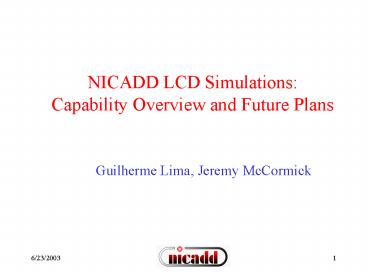NICADD LCD Simulations: - PowerPoint PPT Presentation
1 / 11
Title:
NICADD LCD Simulations:
Description:
Job submission, event generation and detector simulation have little to no User ... XML-based application config file for flexibility ' ... – PowerPoint PPT presentation
Number of Views:22
Avg rating:3.0/5.0
Title: NICADD LCD Simulations:
1
NICADD LCD Simulations Capability Overview and
Future Plans
Guilherme Lima, Jeremy McCormick
2
Current Process Overview
Event Generation
JAS, Pandora-Pythia
stdHEP
Detector Simulation
Gismo
SIO
SIO File Server
SIO File (remote)
JAS
Analysis
Note Each arrow represents a (probable) file
transfer.
3
Event Generation
- Single Particles
- JAS SingPartGen class
- typically electrons, pions or muons
- helpful for debugging and results certification
- typical single particles E 2, 5, 10, 20, 50
GeV - fixed theta/phi or randomized within boundaries
- Complex Events
- pandora-pythia (TAULA, Pandora, Pythia)
- processes include E E-, Gamma Gamma, E- E-,
E-() Gamma, Gamma E-, etc. - multiple processes
4
Detector Simulation
- Gismo
- stdHEP input with SIO output
- C package maintained at SLAC--no longer in
development (difficult to install and uses old
and unsupported toolkits) - version 3.1.1 distribution includes CLHEP
1.4.0.0, stdHEP 4.06 and several XML libraries
(icu, xerces, xml4c) - Geant4 Software
- LCDG4 and LCD-Mokka in beta or alpha.
- Mokka is available for simulations and mutual
results certification.
5
Analysis
- SIO files remotely accessible in JAS
- wired display, MC Tree, MC Table and LCD Event
- browseable database of SIO files
- LCDROOT
6
General Problems
- General Issues
- CVS, messy codebase, lack of documentation,
manpower and expertise, many simultaneous
demands, unclear priorities - utter lack of in-house design docs (Road Map)
- Geometry
- XML limits customization of the detector
geometries. - only idealized structures with limited utility
beyond a certain LCD design phase - Simulator Zoo
- LCDG4 local capability only (nicadd) with no
certification study. - Mokka tested only on pre-defined
detectorsnon-working Mokka geometry drivers for
XML input LCD-Mokka from Ties has a Seg Fault in
XML library. - Non-projective fork of LCDG4 will be difficult
to reintegrate into main trunk. - Pipeline
- perl and bash scripts plus manual command-line
work (Ex. - sftp, ftp or scp for files.) - Job submission, event generation and detector
simulation have little to no User Interface
outside of the command-line. - SIO catalog is manually updated and currently
not up-to-date. - Analysis tools hacked to accommodate geometry
modifications.
7
LCDG4-related Problems
- Extending Difficult
- limited by XML format
- class structure is not well-designed
- sensitive detector and geometry code requires an
overhaul - Codebase
- no support for non-projective readout in main
code trunk - CVS is a mess.
- practically undocumented
- misuses and recodes Geant4 constructs
- coding style, including indentation and variable
naming, is inconsistent - unused code still compiled!
- Structural Problems
- poor class design creates major redundencies and
inefficiencies - supports only LCD XML file format
- lacks a coherent long-term design plan and path
8
Short-term Goals
- LCDG4 and LCD-Mokka mutual results certification
for identical detector geometries - correct text output for LCDG4 with simulated
non-projective cell geometry in HCal - debugged LCDG4 running on the Fermilab cluster
- clean up LCDG4 code remove unused code,
document, standardize on indentation and variable
naming conventions - complete CVS reorganization/reconfig, dropping
old versions from codebase - study Geant4 toolkit to understand class
structures, application scope and built in
capabilities
9
Midterm Plans
- phase out Gismo for a Geant4-based simulator
- coherent design document for a Geant4 simulation
package before the coding effort - OR
- drop LCDG4 in favor of a more mature package
such as Mokka - LCDG4 class restructuring in SD and geometry,
NP in Ecal, projective and non-projective
geometries - modify JAS to easily analyze SIO files based on
changeable geometry formats - plan develop tools pipeline for LCD computing
in all 3 phases - establish collaborative efforts with CERN and
SLAC for LCD simulation tool development with
Geant4 - continue to work on UI for event generation and
simulation tools - design better distribution and packaging system
for NICADD LCD software and results files
10
Ambitious Long-Term Musings
- GDML parsers and translators packaged with
Geant4 - XML format for LCD geometries should be based on
low-level Geant4 volume objects, which GDML
mirrors. GDML does not currently include
sensitive detector information, and this
capability should be either added to the format
or included in a separate XML file, connected to
GDML volumes by ID tags. - STEP file input from CAD to test actual detector
designs, also a Geant4 built-in - translate XML/SQL formats to GDML via XSLT and
relational mappings - full range of tower/non-projective simulation
with cells as reflected volumes - XML-based application config file for
flexibility - "hooks" for analysis/event-gen (Geant4 has
built-in eventgen and visualization capabilities) - flexibility in input and output formats and
locations (remote would be nice) - simulator engine that can be run remotely via
server commands (XML-RPC/CORBA/SOAP) - local computing cluster for pipeline automation
- catalog and distribution system for software and
simulation or event generation result files - Event Generation, Detector Simulation and
Analysis tools must be powerful, flexible and
configurable. - Would you build an LCD without blueprints? No.
Similarly, producing good software usually
requires a design phase.
11
References
- Pandora-Pythia
- http//www-sldnt.slac.stanford.edu/nld/new/Docs/
Generators/PANDORA_PYTHIA.htm - JAS http//www-sldnt.slac.stanford.edu/jas/
- Geant4 http//wwwasd.web.cern.ch/wwwasd/geant4/g
eant4.html - stdHEP http//cepa.fnal.gov/CPD/stdhep/
- SIO (now within LCIO) http//www-it.desy.de/phys
ics/projects/simsoft/lcio/ - Mokka http//polype.in2p3.fr/geant4/tesla/www/mo
kka/mokka.html - Gismo http//www-sldnt.slac.stanford.edu/nld/new
/Docs/Gismo/GismoInstall.htm - LCDG4 http//nicadd.niu.edu/simulations/software
/index.html - fbsnghttp//www-isd.fnal.gov/fbsng/
- Mokka LCDG4 Geometries
- http//nicadd.niu.edu/jeremy/mokka-lcdg4.html
- LCD Simulation at NICADD
- http//nicadd.niu.edu/dhiman/talks/lcdg4_slac03
_030521.pdf - Mokka/LCDG4 Comparison http//www-conf.slac.stan
ford.edu/lcsimworkshop/talks/mokka.pdf - GDML http//gdml.web.cern.ch/gdml/

